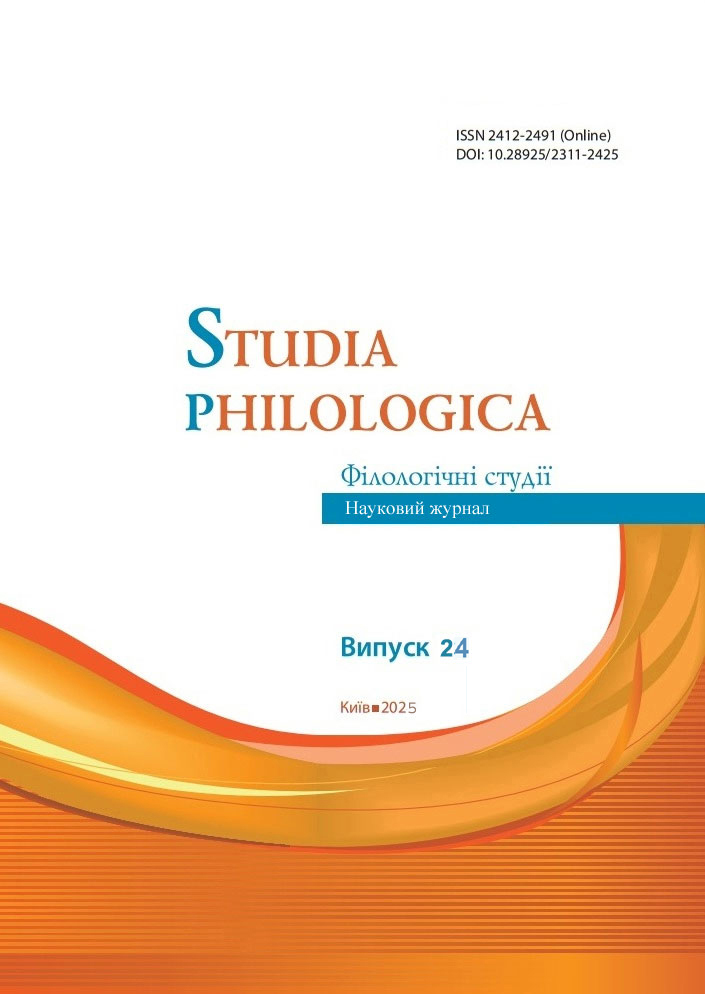Applied and Existential Aspects of the Implementation of the National Standard of Ukrainian Latinics
DOI:
https://doi.org/10.28925/2311-2425.2025.244Keywords:
transliteration, Ukrainian Latinics, transliteration standard, transliteration principles, Cyrillic script, historical textsAbstract
This article aims to consider Latinization systems for Ukrainian language in comparison with transliteration standards of other languages. The basis for this study is the need for a scholarly based Latinization of Ukrainian texts, taking into account the historical development of the Ukrainian language, which has become especially relevant in connection with the real prospects of Ukraine's European integration.
Currently, two different Romanization systems are in force in Ukraine: Resolution No. 55 of the Cabinet of Ministers of Ukraine “On streamlining the transliteration of the Ukrainian alphabet into Latin” dated January 27, 2010, which guides the Romanization of Ukrainian names into English, and the national transliteration standard DSTU 9112:2021 “Information and documentation – Cyrillic-Latin transliteration and Latin-Cyrillic re-transliteration of Ukrainian texts. Writing rules”.
The purpose of this study is to find out the linguistic, technological, historical, legal and existential aspects of Ukraine's practical use of the transliteration norms of the Latinization of Ukrainian texts and to develop appropriate recommendations for the use of these norms.
An objective comparative analysis of approaches generally accepted in world linguistics and in international standardization against the Ukrainian background shows that the transcoding table of Resolution No. 55 of the Cabinet of Ministers of Ukraine does not meet the needs of our state in the field of transliteration.
The main advantages of DSTU 9112:2021 include its compliance with international requirements for transliteration, consistency with the international standard ISO 9:1995 and fixation of the antiquity of the Ukrainian language. Because of this, DSTU 9112:2021 is suitable not only for bibliography, but also for historical monuments of Ukraine and use in modern linguistic technologies that require Latinization. In particular, DSTU 9112:2021 provides an opportunity to restore the original form of texts, which include not only ordinary Ukrainian words, but also abbreviations. This feature makes it indispensable for huge text arrays of millions and billions of words, the transliteration of which takes place automatically.
From a legal point of view, the use of DSTU 9112:2021 will contribute to the practical implementation of the provisions of the Law of Ukraine “On Ensuring the Functioning of the Ukrainian Language as a State Language” regarding the use of the Ukrainian language, studying the Ukrainian language abroad, spread of the Ukrainian language in the world, writing of Ukrainian names, toponyms, and other names.
The best option for Ukraine is the wide implementation of DSTU 9112:2021 “Information and documentation – Cyrillic-Latin transliteration and Latin-Cyrillic re-transliteration of Ukrainian texts. Writing rules”. For this, an appropriate decision must be made at the state level.
Downloads
References
Church Slavic romanization table. (2022). ALA-LC Church Slavic. Retrieved November 16, 2024, from https://www.loc.gov/catdir/cpso/romanization/churchsl.pdf.
Fritz, Richard, & Fritz, Deborah. (2003). MARC 21 for everyone: A practical guide. Chicago.
Hopkinson, Alan. (2008). UNIMARC manual: Bibliographic format. London.
ISO 233:1984. Documentation – Transliteration of Arabic characters into Latin characters. Retrieved November 16, 2024, from https://www.iso.org/obp/ui/#iso:std:iso:233:ed-1:v1:en.
ISO 259:1984. Documentation – Transliteration of Hebrew characters into Latin characters. Retrieved November 16, 2024, from https://www.iso.org/obp/ui/#iso:std:iso:259:ed-1:v1:en.
ISO 9:1995. Information and documentation – Transliteration of Cyrillic characters into Latin characters – Slavic and non-Slavic languages. Retrieved November 16, 2024, from iso.org/standard/3589.html.
ISO 11940:1998. Information and documentation – Transliteration of Thai. Retrieved November 16, 2024, from https://www.iso.org/obp/ui/#iso:std:iso:11940:ed-1:v1:en.
Mair, Victor. (2022). Japanese Romanization: They still haven’t decided. Language log. Retrieved November 16, 2024, from languagelog.ldc.upenn.edu/nll/?p=56461.
Recommended system for Romanizing Japanese. (2009). Department of English language / Komaba Organization for Educational Development. The University of Tokyo, Komaba. Retrieved November 16, 2024, from park.itc.u-tokyo.ac.jp/eigo/UT-Komaba-Romanization-of-Japanese-v1.pdf.
Shevelov, George. (1979). A historical phonology of the Ukrainian language. Heidelberg.
Unicode transliteration guidelines. Unicode CLDR project. 1991–2024. Retrieved November 16, 2024, from https://cldr.unicode.org/index/cldr-spec/transliteration-guidelines.
Vakulenko, M. (2023). Normalization of Ukrainian letters, numerals, and measures for natural language processing. In: Digital Scholarship in the Humanities 38 (3): 1307–1321. Published: 29 December 2022. DOI: 10.1093/llc/fqac090.
Vakulenko, M. (2024). Transliteration. In: Encyclopedia of Slavic Languages and Linguistics Online, Editor-in-Chief: Marc L. Greenberg, General Editor: Lenore A. Grenoble. Retrieved November 16, 2024, from http://dx.doi.org/10.1163/2589-6229_ESLO_COM_038593.
Xing, H., & Feng, X. (2016). The Romanization of Chinese language. Review of Asian and Pacific studies 1, 99–111.
Zeidan, A. (2024). Languages by number of native speakers. Britannica. Retrieved November 16, 2024, from https://www.britannica.com/topic/languages-by-number-of-native-speakers-2228882.
Braichevskyi, M. (2009). Pokhodzhennia slovianskoi pysemnosti [Origin of Slavic Writing] (4th ed.,). Kyiv: Vyd. dim “Kyievo-Mohylianska akademiia”[in Ukrainian].
Vakulenko, M. O. (2015). Ukrainska terminolohiia: kompleksnyi linhvistychnyi analiz [Ukrainian terminology: a comprehensive linguistic analysis]. Ivano-Frankivsk: Foliant [in Ukrainian].
Vakulenko, M. O. (2023). Suchasna ukrainska terminolohiia: metodolohiia, kodyfikatsiia, leksykohrafichna praktyka [Modern Ukrainian terminology: methodology, codification, lexicographic practice]. Doctor’s thesis. Kyiv: Kyivskyi natsionalnyi universytet imeni Tarasa Shevchenka, Ministerstvo osvity i nauky Ukrainy [in Ukrainian].
DSTU 9112:2021 (NEQ ISO 9:1995). Information and documentation - Cyrillic-Latin transliteration and Latin-Cyrillic retransliteration of Ukrainian texts. Spelling rules. Retrieved from https://zakon.rada.gov.ua/rada/show/v0260774-21#Text [in Ukrainian].
Kabinet Ministriv Ukrainy. Pro vporiadkuvannia transliteratsii ukrainskoho alfavitu latynytseiu. 27 sichnia 2010 roku. Postanova № 55 Kabinetu Ministriv Ukrainy [Cabinet of Ministers of Ukraine. On streamlining the transliteration of the Ukrainian alphabet into Latin. 27 January 2010. Resolution No. 55 of the Cabinet of Ministers of Ukraine]. Retrieved from zakon.rada.gov.ua/laws/show/55-2010-%D0%BF#Text [in Ukrainian].
Mozer, M. (2018). Istoriia ukrainskoi movy [History of the Ukrainian language]. Kyiv: Likbez [in Ukrainian].
Nikitina, F. O., Yakovenko, Y. M. (2004). Latynytsia. Ukrainska mova: entsyklopediia [Latin alphabet. Ukrainian language: encyclopaedia] (2nd ed., rev.). Kyiv: Vyd vo “Ukr. entsykl.” im. M. P. Bazhana [in Ukrainian].
Sobolevskii, A. Y. (1907). Lektsiy po ystoriy russkaho yazыka [Lectures on the history of the Russian language]. Moskva: Unyversytetskaia typohrafiia, Strastnoi bulvarъ [in Russian].
Shyrokov, V. A., Shevchenko, I. V. (2005). Otsinka tochnosti fonetychnoho pryntsypu v ukrainskomu pravopysi [Assessment of the accuracy of the phonetic principle in Ukrainian spelling]. Movoznavstvo – Linguistics, 5, 41–46 [in Ukrainian].
Published
How to Cite
Issue
Section
License
Copyright (c) 2025 CC BY 4.0 DEED Attribution 4.0 International

This work is licensed under a Creative Commons Attribution 4.0 International License.


